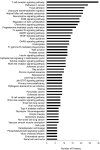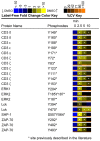ERK positive feedback regulates a widespread network of tyrosine phosphorylation sites across canonical T cell signaling and actin cytoskeletal proteins in Jurkat T cells
- PMID: 23874979
- PMCID: PMC3714263
- DOI: 10.1371/journal.pone.0069641
ERK positive feedback regulates a widespread network of tyrosine phosphorylation sites across canonical T cell signaling and actin cytoskeletal proteins in Jurkat T cells
Abstract
Competing positive and negative signaling feedback pathways play a critical role in tuning the sensitivity of T cell receptor activation by creating an ultrasensitive, bistable switch to selectively enhance responses to foreign ligands while suppressing signals from self peptides. In response to T cell receptor agonist engagement, ERK is activated to positively regulate T cell receptor signaling through phosphorylation of Ser(59) Lck. To obtain a wide-scale view of the role of ERK in propagating T cell receptor signaling, a quantitative phosphoproteomic analysis of 322 tyrosine phosphorylation sites by mass spectrometry was performed on the human Jurkat T cell line in the presence of U0126, an inhibitor of ERK activation. Relative to controls, U0126-treated cells showed constitutive decreases in phosphorylation through a T cell receptor stimulation time course on tyrosine residues found on upstream signaling proteins (CD3 chains, Lck, ZAP-70), as well as downstream signaling proteins (VAV1, PLCγ1, Itk, NCK1). Additional constitutive decreases in phosphorylation were found on the majority of identified proteins implicated in the regulation of actin cytoskeleton pathway. Although the majority of identified sites on T cell receptor signaling proteins showed decreases in phosphorylation, Tyr(598) of ZAP-70 showed elevated phosphorylation in response to U0126 treatment, suggesting differential regulation of this site via ERK feedback. These findings shed new light on ERK's role in positive feedback in T cell receptor signaling and reveal novel signaling events that are regulated by this kinase, which may fine tune T cell receptor activation.
Conflict of interest statement
Figures












Similar articles
-
Vav1 Regulates T-Cell Activation through a Feedback Mechanism and Crosstalk between the T-Cell Receptor and CD28.J Proteome Res. 2015 Jul 2;14(7):2963-75. doi: 10.1021/acs.jproteome.5b00340. Epub 2015 Jun 16. J Proteome Res. 2015. PMID: 26043137 Free PMC article.
-
SRC homology 2 domain-containing leukocyte phosphoprotein of 76 kDa (SLP-76) N-terminal tyrosine residues regulate a dynamic signaling equilibrium involving feedback of proximal T-cell receptor (TCR) signaling.Mol Cell Proteomics. 2015 Jan;14(1):30-40. doi: 10.1074/mcp.M114.037861. Epub 2014 Oct 14. Mol Cell Proteomics. 2015. PMID: 25316710 Free PMC article.
-
A PLC-γ1 Feedback Pathway Regulates Lck Substrate Phosphorylation at the T-Cell Receptor and SLP-76 Complex.J Proteome Res. 2017 Aug 4;16(8):2729-2742. doi: 10.1021/acs.jproteome.6b01026. Epub 2017 Jul 6. J Proteome Res. 2017. PMID: 28644030 Free PMC article.
-
Collagen-mediated survival signaling is modulated by CD45 in Jurkat T cells.Mol Immunol. 2007 Jul;44(15):3682-90. doi: 10.1016/j.molimm.2007.04.005. Epub 2007 May 23. Mol Immunol. 2007. PMID: 17524482
-
Stretching the limits of extracellular signal-related kinase (ERK) signaling - Cell mechanosensing to ERK activation.Curr Opin Cell Biol. 2023 Oct;84:102217. doi: 10.1016/j.ceb.2023.102217. Epub 2023 Aug 11. Curr Opin Cell Biol. 2023. PMID: 37574635 Review.
Cited by
-
The catalytic activity of the kinase ZAP-70 mediates basal signaling and negative feedback of the T cell receptor pathway.Sci Signal. 2015 May 19;8(377):ra49. doi: 10.1126/scisignal.2005596. Sci Signal. 2015. PMID: 25990959 Free PMC article.
-
G protein subunit phosphorylation as a regulatory mechanism in heterotrimeric G protein signaling in mammals, yeast, and plants.Biochem J. 2018 Nov 9;475(21):3331-3357. doi: 10.1042/BCJ20160819. Biochem J. 2018. PMID: 30413679 Free PMC article. Review.
-
HIPK2-T566 autophosphorylation diversely contributes to UV- and doxorubicin-induced HIPK2 activation.Oncotarget. 2017 Mar 7;8(10):16744-16754. doi: 10.18632/oncotarget.14421. Oncotarget. 2017. PMID: 28060750 Free PMC article.
-
Lighting Up T Lymphocyte Signaling with Quantitative Phosphoproteomics.Front Immunol. 2017 Aug 9;8:938. doi: 10.3389/fimmu.2017.00938. eCollection 2017. Front Immunol. 2017. PMID: 28848546 Free PMC article. Review.
-
Fibroblasts Mobilize Tumor Cell Glycogen to Promote Proliferation and Metastasis.Cell Metab. 2019 Jan 8;29(1):141-155.e9. doi: 10.1016/j.cmet.2018.08.007. Epub 2018 Aug 30. Cell Metab. 2019. PMID: 30174305 Free PMC article.
References
-
- Acuto O, Di Bartolo V, Micheli F (2008) Tailoring T-cell receptor signals by proximal negative feedback mechanisms. Nat Rev Immunol 8: 699–712. - PubMed
-
- Palacios EH, Weiss A (2004) Function of the Src-family kinases, Lck and Fyn, in T-cell development and activation. Oncogene 23: 7990–8000. - PubMed
-
- Au-Yeung BB, Deindl S, Hsu LY, Palacios EH, Levin SE, et al. (2009) The structure, regulation, and function of ZAP-70. Immunol Rev 228: 41–57. - PubMed
-
- Stefanova I, Hemmer B, Vergelli M, Martin R, Biddison WE, et al. (2003) TCR ligand discrimination is enforced by competing ERK positive and SHP-1 negative feedback pathways. Nat Immunol 4: 248–254. - PubMed
-
- Mueller DL (2003) Tuning the immune system: competing positive and negative feedback loops. Nat Immunol 4: 210–211. - PubMed
Publication types
MeSH terms
Substances
Grants and funding
LinkOut - more resources
Full Text Sources
Other Literature Sources
Molecular Biology Databases
Research Materials
Miscellaneous

